
If you see that the VGA light on your motherboard is on, your Graphics Processing Unit (GPU) probably isn't being detected. Usually, this happens due to loose connections. You'll have to open your PC's case and make sure your GPU is secured in place. In most instances that I've dealt with the problem, I've been able to fix it by tightening my GPU.
But sometimes, your Power Supply Unit (PSU) can be the culprit. You can use the Newegg tool to figure this out. It'll tell you how many watts your PC parts need, which you can compare with your PSU's specs.
If you want to know more about how to get rid of the VGA light on the motherboard, I've run through everything you need to know below.
Contents
Before I run you through some fixes, first rule out whether your motherboard and graphics card is compatible. Sites like Buildmypc can help figure this out. If they are not compatible, none of the fixes below will work. You'll have to swap to a graphics card that actually works (use Buildmypc to find a proper one).
With that out of the way, let's talk about some fixes.

If your graphics card is loose, your motherboard obviously wouldn't be able to detect it. Either you forgot to connect your GPU properly, or one of your PCIe slots are broken. You can fix this by removing and then reattaching your graphic card.
Here's how you do this:
You shouldn't see a VGA LED warning light anymore. But like I said, you should check whether your PCIE slots have been damaged. Your GPU wouldn't be able to properly connect to your motherboard if this is the case, and you'll have to get your motherboard fixed.
Your computer can't work properly if your PSU doesn't send enough wattage. Along with all kinds of other problems, your PSU not sending enough power can cause your motherboard to be able to read your graphics card.
This is where sites like Newegg can help. Once you've entered your PC's specs into it, it will tell you how much wattage you'll need. From here, you can check this other guide that I've written. It will tell you how to check how much power your PSU can supply.
If you didn't know, your computer's BIOS helps it to boot up. At the end of the day, it's a vital component, as it tells all the hardware connected to your CPU to start working. So, you can get stuck with the VGA lights issue if your BIOS acts up.
Just like with your computer's operating system, you need to be regularly updating your BIOS, unless you want it to bug out.
There's no one size fits all way to update BIOS - it all depends on your PC and motherboard model. But there are some basic instructions that you might find useful. Here's what you can do:
If updating your BIOS didn't work, then you might have to try and reset it. There are 2 different ways that you can do this. And thankfully, none of them are too hard.
Here's method 1:
Here's method 2 (with the CMOS battery):
I know a few users who have been able to get rid of the VGA lights by removing and reattaching their RAM Cards.
Here's how you can try this too:
I probably don't need to tell you how big of an issue your PC overheating can be. Almost always, dust being stuck in your CPU fan causes PCs to heat up. This ultimately can turn on the VGA light, as your motherboard won't be able to properly work.
There actually are a few signs if you're dealing with overheating, like your PC making a lot of noise, your desktop regularly crashing, and overall slugging performance. But to get a more exact answer, you can use the Core Temp tool out.
Once you've figured that you're dealing with overheating, here's how you go ahead and give your fans a good clean:
Answered below are some popular questions.
Apart from the VGA light on the motherboard, there are a few other LED lights that you have to watch out for. If there is a DRAM light, your RAM card isn't registered. And if you see a light near BOOT, this means that your boot devices can't be detected.
A lot of the time, you see the VGA LED light when your display isn't working. So, you're likely having some kind of issue with your dedicated graphics card, like your system heating up, or your BIOS being outdated. I've already run through how you can fix all of these earlier.
But if you don't see the VGA light, then you might have some kind of hardware issue at hand. I would recommend that you examine your computer's display. It might be damaged and have been the culprit this whole time.
Now, If your computer screen looks intact, then some other hardware components might be interfering with your display. Fixing this will be easy, as all you have to do is disconnect all of your peripherals, and then re-attach them. Remember to do this one by one so that you'll see which of them is causing the problem (and then remove or replace it).
Sometimes, the issue can also be due to really bad bugs. Make sure you've updated your operating system.
Here's how you can update Windows:
If you see VGA LED lights on your motherboard, this basically means that it's having trouble detecting your integrated GPU. First of all, your graphics card might not be connected properly to your CPU. So, check its PCIE slots out. You may also be dealing with BIOS related problems, like your BIOS settings being faulty, or even outdated.
Also, the red light on the motherboard can pop up if your graphics card is broken, or incompatible with your CPU. Replacing the graphics card is the only way to fix it.
Hopefully, you found all of the points that were run through useful.
